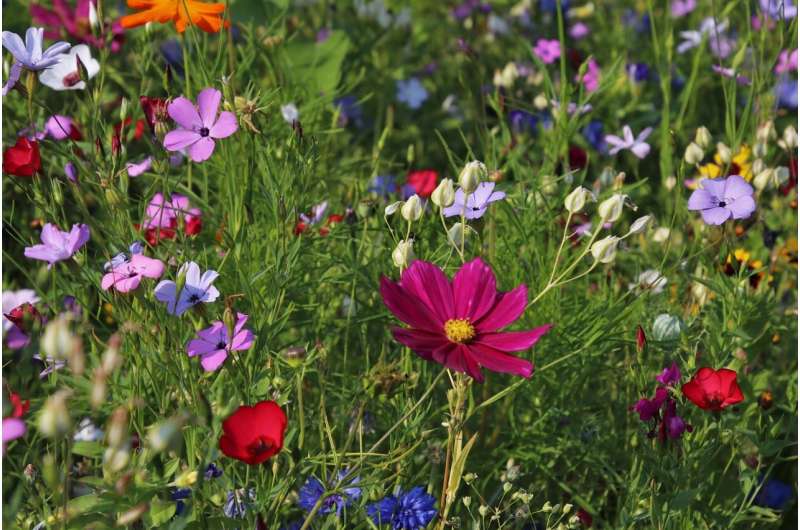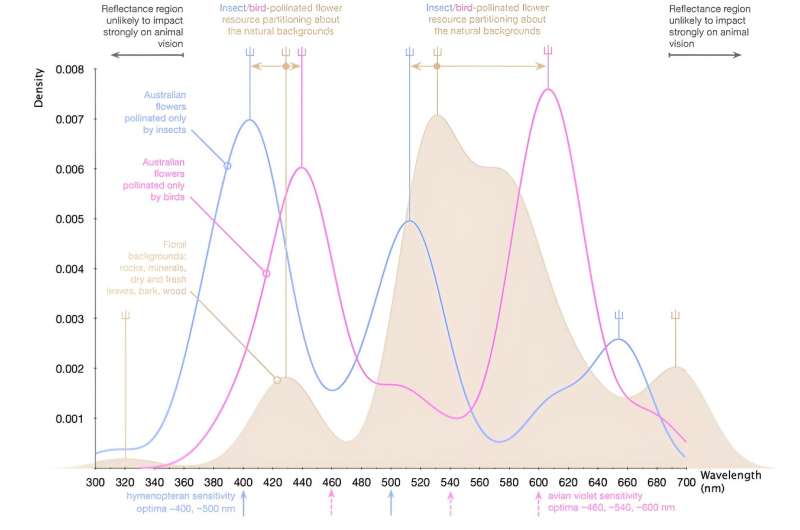This article has been reviewed according to Science X's editorial process and policies. Editors have highlighted the following attributes while ensuring the content's credibility:
fact-checked
peer-reviewed publication
trusted source
written by researcher(s)
proofread
The first flowers evolved before bees—so how did they become so dazzling?

Colorful flowers, and the insects and birds that fly among their dazzling displays, are a joy of nature. But how did early relationships between flower color and animal pollinators emerge?
In a study published in Proceedings of the Royal Society, we have unraveled this mystery by analyzing the visual environments in which the ancestors of today's bees foraged from flowers.
We measured and analyzed the light reflected from today's flowers, as well as the rocks, soil, sticks, bark and leaves that form their natural backgrounds.
From this data, we built computer simulations that recreate the ancient visual environment when the first flowers emerged.
Insect color vision came before flowers
Today, bees are prolific pollinators of flowering plants, including food crops. Bees use color vision based on ultraviolet, blue and green sensitive photoreceptors (light-sensing cells) to detect and discriminate the most rewarding flowers. In comparison, most humans perceive color using blue, green and red sensitive photoreceptors.
When the first flowers evolved during the Mesozoic era, between 252 million and 66 million years ago, the ancestors of bees had to orientate themselves, maintain stable flight, avoid collisions, and find food among natural backgrounds. We suspect their visual systems may have been influenced by evolution to efficiently operate in that environment.
By the time the first flowering plants appeared, bees' ancestors had already evolved color vision—and we know it has stuck around throughout the evolutionary history of bees.
So, while bees weren't initially around, their ancestors were. Flower colors likely evolved the vivid colors we see today to suit this ancient visual system. At the same time, the first bees emerged as the most efficient pollinators.

What color were flower backgrounds on the ancient Earth?
Australia is an ideal place to collect data on natural background materials that early insects would have seen, as it is a geologically ancient continent.
We collected background samples from across Australia and measured their reflective properties using a tool called a spectrophotometer.
We used this data to create a database of materials that would have been present in the visual environment of flying insects more than 100 million years ago—when the first flowers appeared.
Flower color evolved in response to bee color vision
For our collection of natural backgrounds, insect and bird-pollinated flowers, we calculated marker points—rapid changes in the intensity of light reflected from a surface, within a small wavelength band.
These marker points identify the key visual features of colored surfaces, and we can use them for statistical testing of the evolutionary process.
We then wrote computer simulations to generate possible flower backgrounds. By analyzing their marker points, we tested the visibility of today's flowers against the simulated backgrounds.
Interestingly, we showed that the distribution of marker points on petals from plants pollinated by bees clearly indicates these flowers are "salient"—that is, they stand out as stronger signals from natural backgrounds.
This finding matches with previous studies suggesting that in the Northern Hemisphere and Australia, flowering plants evolved color signals to facilitate color perception by bees.
The very first flowers were likely a dull greenish-yellow color and initially pollinated by flies. However, as the first bees—with their tuned vision systems—started pollinating flowers, the flowers likely evolved new colors to match the bees' visual capabilities.
The process of natural selection seems to have driven flower colors to stand out from their backgrounds in the eyes of pollinators.
Birds were involved, too
Birds became established as flower visitors millions of years after insect pollination evolved. Bird vision uses four types of color photoreceptors, and they can see long-wavelength red colors that bees cannot easily process against natural backgrounds.
Our analysis confirmed that bird-pollinated flowers evolved marker points towards longer wavelengths than bee-pollinated flowers. Our new discovery also showed that these flowers systematically differ from natural backgrounds.
As Earth's climate changes, it is important to consider what might happen to ecosystems and our food production systems in a world without bees. It is vital that we understand how pollination and plant reproduction may be altered.
Our research shows that bees are a major driver of floral evolution. Unless we protect these insects and their habitat, we will lose fundamental and beautiful aspects of life we all enjoy and need.
More information: Alan Dorin et al, Ancient insect vision tuned for flight among rocks and plants underpins natural flower colour diversity, Proceedings of the Royal Society B: Biological Sciences (2023). DOI: 10.1098/rspb.2023.2018
Journal information: Proceedings of the Royal Society B , Proceedings of the Royal Society
Provided by The Conversation
This article is republished from The Conversation under a Creative Commons license. Read the original article.![]()





















